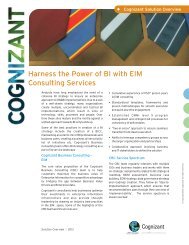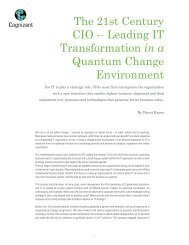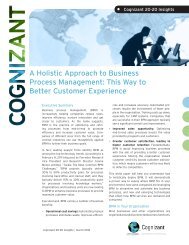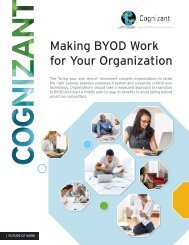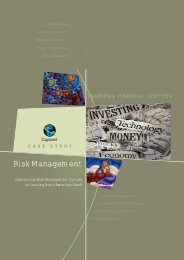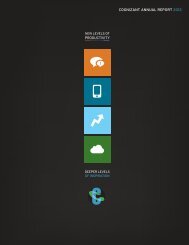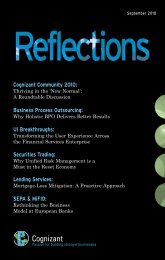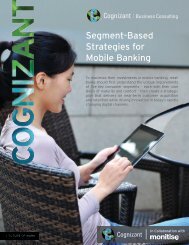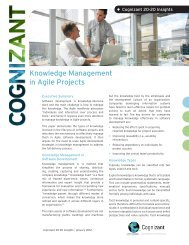Don't Get SMACked: How Social, Mobile, Analytics and ... - Cognizant
Don't Get SMACked: How Social, Mobile, Analytics and ... - Cognizant
Don't Get SMACked: How Social, Mobile, Analytics and ... - Cognizant
Create successful ePaper yourself
Turn your PDF publications into a flip-book with our unique Google optimized e-Paper software.
Executive SummaryThe consumer technology model is now penetrating, <strong>and</strong> beginning to transform, the corporationin a significant way. This new IT architecture, which we call the “SMAC stack” (for social, mobile,analytics <strong>and</strong> cloud), is enabling the creation of hyper-intelligent software platforms that addressmyriad issues, from sales to customer service to the design of new products to the managementprocess. In short, the SMAC stack does notrepresent the next new technology to be“bolted onto” your existing business model.Instead, these technologies will transformthe business model itself.This white paper outlines three key interrelatedissues:The SMAC stack does not representthe next new technology to be“bolted onto” your existingbusiness model. Instead, thesetechnologies will transform thebusiness model, itself.1. Technology: The SMAC Stack. The nextmaster architecture for enterprise IT, <strong>and</strong> its magnitude <strong>and</strong> importance.2. Business Models: “Unchained Businesses.” <strong>How</strong> the SMAC stack will lead to the unbundlingof tightly-coupled, industrial-age value chains, transforming key processes <strong>and</strong>, insome cases, entire industry structures.3. Killer Processes: Ground Zero for Change. Successful transformations will occur in focusedareas of the business in which the SMAC stack is already changing the competitiveequation.Whether you’re a general manager, head of information technology or leading your company’sstrategy, a decade from now, you’ll be asked the same two questions: Did you see this technologybasedsea change coming? And, once you did, what did you do about it? This paper is intendedto help you answer those questions well.DON’T GET SMACKED 3
By no means is this story isolated to newspapers. Another example of the efficiency <strong>and</strong> disruption of a business model basedon the SMAC stack is highlighted by the metrics of 11-year-old Wikipedia vs. 244-year-old Encyclopedia Britannica. Figure 1reveals the incredible scale advantages of the SMAC-stack powered Wikipedia.Knowledge TransformationEncyclopedia Britannica WikipediaYear founded 1768 2001Articles 65,000 4,086,999*Languages 1 271Words 40 million 2 billionUpdated Annually Real-timeMistakes per article 2.92 3.86Cost $729 Free*”Wikipedia Statistics,” Wikipedia, Aug. 31, 2012, http://stats.wikimedia.org/EN/Sitemap.htm.Source: Company reportsFigure 1Small wonder that Encyclopedia Britannica published its last physical version in early 2012.Craigslist <strong>and</strong> Wikipedia st<strong>and</strong> as extreme, yet simple, examples of dematerialization: the process by which material-basedvalue chains go virtual. <strong>How</strong> many similar knowledge-based processes — now incorrectly structured <strong>and</strong> managed as industrialprocesses — exist in your organization?This unbundling or dematerialization of knowledge processes is at the heart of many industry transformations. Figure 2highlights the significant displacement occurring as a result of the proper implementation of SMAC stack technologies.Model ChangeIndustry Widget Winners Digit Winners Tipping PointsBook retailing Borders Amazon Borders bankrupt 2011; Amazon market cap, $99 billion.Movie rentals Blockbuster Netflix Blockbuster bankrupt 2011; Netflix streaming volumeexceeds rentals in 2012 <strong>and</strong> constitutes one-quarter ofU.S. Internet traffic.<strong>Mobile</strong> phones Nokia Apple, Google Nokia market share at 1997 levels, 3% of peak marketcap; Apple market cap, $500 billion; Google market cap,$215 billion.Online communicationplatformAOL Facebook AOL value 95% from peak; Facebook market cap, $48billion.Photographs Kodak Flickr,ShutterflyMaps R<strong>and</strong> McNally TomTom,Garmin, GoogleSource: Company reports; valuations as of mid-November, 2012Figure 2Kodak files for bankruptcy in early 2012.Garmin market cap, $7 billion.DON’T GET SMACKED 5
In every case, the industrial model (or widget) winners held significant advantages in br<strong>and</strong> awareness, customer relationships,distribution channels, research <strong>and</strong> development capabilities, management experience, employee depth, balance sheets <strong>and</strong>market valuation. Yet, the digit winners possessed one key advantage: Their value chains were in harmony with the realities oftoday’s information-based markets, because they had mastered the SMAC stack technologies. By 2012, they had all triumphed,pushing widget “champions” to either bankruptcy or market valuations 90% off their peaks.In hindsight, the fight wasn’t even fair.What’s going on today is not the digitization of products, but the digitization (<strong>and</strong> resulting virtualization) of entire businessmodels. In this new l<strong>and</strong>scape, it doesn’t matter how hard your organization works, how well you manage or what resources areat your disposal; if you are competing with an antiquated business model, you are at risk of facing your own Kodak moment.Denial in industrial-age firms can be palpable, even in the most informed organizations. As stated by George Jones, CEO ofBorders Group in 2008:“What I found most compelling was the Borders br<strong>and</strong> <strong>and</strong> the people. Borders is a muchloved,highly regarded br<strong>and</strong> with some of the most intelligent <strong>and</strong> engaged employees I’veworked with in the retail industry.” 6Fewer than four years later, Borders was out of business. It got <strong>SMACked</strong>.Make sure your organization doesn’t get <strong>SMACked</strong> by this new technology wave. Instead, underst<strong>and</strong> it, <strong>and</strong> learn how to rideit. Start by focusing enterprise attention <strong>and</strong> resources on three key, interrelated issues:1. Technology: Harness the multiplying effect of the SMAC stack to transform your business.2. Business Models: “Unchain” your industrial value chain by creating boundaryless ways of working within your organization<strong>and</strong> with business partners <strong>and</strong> customers.3. Focal Points: Identify key knowledge process areas where the confluence of new technologies <strong>and</strong> ways of working cantruly differentiate your business.Part I: The SMAC StackMastering the Fifth Wave of Corporate ITThe year 2012 is a very important one in corporate IT, as the social, mobile, analytics <strong>and</strong> cloud technologies that have sodominated the consumer experience for the past several years entered the enterprise world in a meaningful way, laying thefoundation for a new master corporate IT architecture.To date, there have been four master corporate technology architectures: the mainframe, the minicomputer, client/server<strong>and</strong> the Internet. Each of these eras lasted roughly a decade <strong>and</strong> (as outlined by the “S” curves in Figure 3, next page) drovebusiness productivity higher during those periods.Each architecture focused on key business processes <strong>and</strong> supported “killer” technology applications (such as ERP with client/server <strong>and</strong> e-commerce with the Internet) to drive new levels of value. <strong>How</strong>ever, once those architectures were in place, earlyproductivity gains waned, <strong>and</strong> investments reached points of diminishing returns (which is why the top of each “S” goes flat).After all, once you’ve put your ERP backbone in place, you don’t need a second one.Today, it’s clear we are at the top of the fourth curve <strong>and</strong> starting to jump to the fifth. As with other “curve jumps,” this shift willgenerate significant dislocation <strong>and</strong> wealth creation on the supply (or vendor) side of the industry — across hardware, software<strong>and</strong> services sectors — <strong>and</strong> drive new levels of productivity on the dem<strong>and</strong> (or user) side of the industry.SMAC as a Technology Stack: No Technology Is an Isl<strong>and</strong>Key to underst<strong>and</strong>ing this transition — <strong>and</strong> knowing what to do about it — is in viewing SMAC technologies as a “stack,” as anintegrated architecture. Imagine your smartphone without its apps, disconnected from the Web, the cloud <strong>and</strong> your personalnetworks. On its own, it would a very expensive pocket watch.6 FUTURE OF WORK November 2012
Catching the Fifth Wave of Corporate ITBusinessProductivitySMAC stack2012-?InternetPC2002-2012Mainframe1960-1976Distributed PC199220 1992-2001Minicomputer1976-1992TimeFigure 3The same is true with corporate technologies. Over the past few years, the potential of the discrete “piece parts” of this newtechnology architecture has been oversold, for when cloud or mobile technologies are implemented in st<strong>and</strong>-alone fashion,they rarely deliver meaningful business value.<strong>How</strong>ever, when these technologies are deployed asan integrated stack, they have a multiplier effect(e.g., mobile inputs driving real-time analytics)that can serve as the foundation for breakthroughbusiness results.This phenomenon is similar to the early days ofthe client/server wave. That is, in the late ‘80s <strong>and</strong>early ‘90s, various components of the client/serverarchitecture — such as relational databases, Ethernetnetworks, Unix operating systems <strong>and</strong> PCs — were allcommercially available. While the technical superiorityof these piece-parts were recognized in technologycircles, when implemented in st<strong>and</strong>-alone fashion,little business value was created. In fact, much value(<strong>and</strong> IT credibility) was destroyed when IT managersattempted to glue individual client/server technologiesonto minicomputer architectures (e.g., replacingminicomputer servers with Unix servers). Only whenThe power of disruptive businessmodels — such as those pioneeredby Facebook, Apple, Netflix,Amazon, Google, etc. —originates from managing SMACtechnologies as an integratedstack <strong>and</strong> fundamentally enablingbusiness models by using thisintegrated technology stack.client/server technologies were implemented as a stack, as enterprise application solutions that drove business value, did thearchitecture take hold (with the PCs atop Unix servers, connected over networks <strong>and</strong> tapping into relational databases).DON’T GET SMACKED 7
Quick TakeA History of Technology Shifts1. The Mainframe Era: 100,000 computersThis market topped out at roughly 100,000 computersworldwide (combining the approximately 15,000 mainframesinstalled at the height of this era 8 <strong>and</strong> all of theancillary computing devices attached to these machines).2. The Minicomputer Era: 10 million computers, 2.6exabytes of data 9Led by companies such as Digital Equipment Corp., DataGeneral, Wang, Prime Computer <strong>and</strong> Stratus, this eraushered in a trend of smaller, departmental computers(ironically — by today’s st<strong>and</strong>ards — called “mini,” as the1.5- pound iPad has significantly more processing powerthan the 750-pound DEC VAX of 1980). At the end of theminicomputer era, approximately 10 million computingunits were installed across enterprises worldwide, with 2.6exabytes of data under management.3. The Client/Server Era: 100 million computers, 15.8exabytes of dataThe early 1990s brought another order of magnitudegrowth in computers in the enterprise. Once the PCs, Unixboxes <strong>and</strong> network routers were installed to run the newenterprise systems, more than 100 million computers weresold, with 15.8 exabytes of data in the associated databases.4. The Internet Era: 1 billion computers, 54.5 exabytes ofdataConnectivity to an entire new generation of devices <strong>and</strong>users drove the number of computers worldwide to 1 billion<strong>and</strong> tripled data under management to 54.5 exabytes.5. The SMAC Stack: 10 billion computers, 1,800 exabytesof dataThe number of computers is quickly on its way to 100billion, <strong>and</strong> data volume is growing to 35,000 exabytes(more than 600 times the data under management at theend of the Internet era).Step One (2012-2015): Mobility <strong>and</strong> <strong>Analytics</strong> Lead the WayBy 2015, we will have roughly 10 billion computing devices in use, generating 1,800 exabytes of data. (Yes, we will soon crossthe line where there are more computers on earth than people. If this number seems overstated to you, simply take inventoryof the smartphones, tablets, PCs <strong>and</strong> gaming consoles in your home … then take inventory of your work-related devices.) Thenumber of computers has been largely driven by human usage, with dramatic growth at each layer of the SMAC stack. Inparticular, the growth in mobility <strong>and</strong> data highlights the need to focus on thesetwo areas in the near term.<strong>Mobile</strong>: “The smartphone in your pocket has more computing power than allof NASA did when it put a man on the moon in 1969.” 10And yet all you do is play angry birds.We will soon cross theline where there aremore computers onearth than people.Seriously, when it comes to mobile adoption, we are very close to full marketsaturation. That is, by now you should assume that any customer you want tosell to, or any talented employee you wish to hire, is carrying a sophisticated smart device at all times. What’s now important isnot who has a smart device, but what they are doing with it. They’re already doing a lot, <strong>and</strong> this will only accelerate over time.For example:• In 2012, mobile network data will exceed fixed network data for the first time. 11• 45 billion mobile apps will be downloaded in 2012, <strong>and</strong> it is predicted over 200 billion will be downloaded in 2015. 12• <strong>Mobile</strong> apps will grow from a $6 billion industry today to a $55.7 billion industry by 2015. 13• <strong>Mobile</strong> unit sales are now more than double those of PCs, <strong>and</strong> mobile device revenue has also surpassed PC revenues. 14• The number of smartphone shipments is expected to be one billion in 2016. 15• After its first weekend on the market in September 2012, the iPhone 5 sold 5 million units. 16• From May to December 2011, the number of Android Market apps doubled to more than 400,000 apps. 17DON’T GET SMACKED 9
• We are entering an era of explosive growth incomputing devices <strong>and</strong> data creation.• We are on the cusp of the “Internet of Things,” atipping point when most computing devices, <strong>and</strong>the majority of data created, are done so withouthuman intervention.PART II: The Natural State ofOrganizationThe Age of the Great Decoupling <strong>and</strong>DematerializationIn nature, elements become unstable with significantchanges in temperature, <strong>and</strong> must transform to regainharmony with their environment. Similarly, manybusinesses have become highly instable in this era ofhyperconnectivity. Just as rising temperatures forcechange upon matter (with, say, ice turning to water),today’s rapid rise of information is forcing structuralchange upon many corporate models.Quick TakeTalking SMACOverwhelmed by SMAC’s rapid ascension? Here are three keyquestions your organization should be solving for now:1. <strong>How</strong> do you manage in a world where “everything”(machines <strong>and</strong> humans) is IP addressable <strong>and</strong> alwaysonline?2. What happens when the data surrounding your companygrows 50-fold in the next 10 years?3. What happens when information in your companytranscends its traditional physical boundaries, beyonddepartments, companies, industries <strong>and</strong> countries?Structural Changes in NatureEach year in New Engl<strong>and</strong> the changes in season turn winter’s ice rink into summer’s swimming pond. Whether one skates onthe ice, swims in the water or stares up into the clouds, the integrity of the water in any of its forms is never questioned. Wateris water, for regardless of its state, it is always two parts hydrogen, one part oxygen. Importantly, we inherently underst<strong>and</strong> thestability of each form given its environment (see Figure 5).Today, there’s a strong parallel between the natural states of matter <strong>and</strong> the proper, or natural, state of an organization. Just asthe state of matter naturally changes with increases in temperature, the state of the organization must change with meaningfulincreases in information (see Figure 6).Unfortunately, too many managers today are confused. They focus on the state of their organization instead of its substance.For example, management at retailers such as Borders <strong>and</strong> Blockbuster defined themselves as physical retailers that happenedto sell books or rent videos, instead of book <strong>and</strong> video providers that needed to take on the appropriate form for their marketcontext. Incorrectly conceptualizing the business proved deadly in those markets.States of MatterSolid• Holds shape.• Fixed volume.Liquid• Shape of container.• Free surface.• Fixed volume.HeatGas• Shape of container.• Volume of container.Figure 5DON’T GET SMACKED 11
Rearchitecting for Information MarketsThe over-arching business challenge of the next decade is to reestablish balance between a business <strong>and</strong> its overall ecosystemcontext, <strong>and</strong> to reset business to the customer expectations <strong>and</strong> financial realities afforded by the SMAC stack. The rapid growthin computing devices <strong>and</strong> data (outlined above) will soon drive many industries to a “tipping point,” where the economics ofinformation will usurp those of capital <strong>and</strong> hard assets.This is the natural state of organization. The SMAC stack will drive structural change in the corporation (see sidebar, next page).States of OrganizationTightly Coupled• Widget-based value chain.• Physical coupling ofpeople <strong>and</strong> process.Hybrid• Widget-digit value chain.• Combination of physical<strong>and</strong> virtual coupling ofpeople <strong>and</strong> process.Loosely Coupled• Digit-based value web.• Virtual coupling ofpeople <strong>and</strong> process.InformationFigure 6Tightly-Coupled Value Chains Morph into Loosely-Coupled Value WebsChallenging the Fundamental Underpinnings of Value ChainsMany of today’s senior managers — industry aside — grew up with the Michael Porter “value chain model” of businessmanagement 26 (see Figure 7, next page). This value chain model, which breaks down a company’s key activities <strong>and</strong> the linkagesbetween such activities, had fundamental underpinnings based on industrial-age assumptions:• Communication costs were expensive.• Humans <strong>and</strong> information had to be co-located.• Coordination costs were high (leading to internal ownership).• Information was finite <strong>and</strong> proprietary.Due to these constraints, the “molecules” of this value chain model (both functions <strong>and</strong> people) had to be co-located, or “tightly-coupled,”much like the molecules in a solid. Additionally, most companies found it more efficient <strong>and</strong> effective to own asmany aspects of the value chain as possible. This is precisely why, for example, in building Ford Motor Co. <strong>and</strong> General Motors,Henry Ford <strong>and</strong> Alfred Sloane built massive factories, mostly in Detroit, to sit atop their vertically integrated value chains. Withthe high costs of communication, <strong>and</strong> relatively low levels of information flows, it was imperative to have people, processes <strong>and</strong>functions all co-located.This seminal organization model has served as a blueprint of organizational design for nearly a century, regardless of the natureof a company’s product or service. With the emergence of the SMAC stack, such business model design in many situations isnow fatally flawed, as the four key pillars of industrial business design are under assault:12 FUTURE OF WORK November 2012
Quick TakeSMAC Stack Effects Driving Corporate Dematerialization1. The Google Effect: The separation of humans <strong>and</strong> information• The last time you “Googled” something, did you stop <strong>and</strong>think, “Hmmm, I wonder if these results came from adatabase in a server farm in Oregon, Georgia or Virginia,or maybe from The Netherl<strong>and</strong>s or Australia?” 25 Ofcourse not. Through the Google Effect, information <strong>and</strong>physical location in our personal lives have been fullyvirtualized <strong>and</strong> dematerialized. So why, in many corporations,are the two (very expensively) still co-located?2. The Skype Effect: Free communications, death ofdistance• Remember (readers of a “certain age”) when thephysical distance of a long-distance phone call reallymattered? When a call of 10 miles was significantlycheaper than a call of 1,000 miles, <strong>and</strong> an overseas callwas a true luxury? Today, IP-based communicationplatforms (whether video, voice or e-mail) have cost<strong>and</strong> usage bases that have nothing to do with distance;speaking to someone around the world on an IP networkis the same as speaking across the street. Now that thecost of moving digital bits around a global company <strong>and</strong>to its customers <strong>and</strong> suppliers has fallen to near zero, asurfeit of information that was historically unaffordableto transmit is now affordable to consume.3. The Facebook Effect: The virtualization of humanrelationships• Fundamental to Facebook’s immense popularity isit allows for the maintenance <strong>and</strong> enhancement ofpersonal relationships, even in the absence of regularphysical presence. The same is now available in thecorporate operating model, where working relationshipsbased on capability <strong>and</strong> mutual trust no longer need tobe physically proximate.4. The LinkedIn Effect: The virtualization of specializedknowledge• LinkedIn allows us to map our professional networks,<strong>and</strong> then to quickly locate trusted expertise. Why can’torganizations work in the same manner? The LinkedInEffect gives us a map to our personal networks, <strong>and</strong>the same needs to be developed within corporations toenable the virtualization of expertise, to allow for theright person to be brought to the right task at the righttime.5. The Amazon Effect: The virtualization of customerexperience• Amazon knows you better than the manager at yourcorner store. In certain ways, Amazon may know youbetter than many of your family members. Yet, whenwas the last time you met anybody from Amazon? Thisvirtualization of customer intimacy is led by (but notthe sole domain of) SMAC stack leaders like Amazon,Netflix <strong>and</strong> Apple. It is available to all organizations, <strong>and</strong>in the next decade (driven by social CRM), we will seea massive dematerialization at the customer interface.• Communication costs, for all intents <strong>and</strong> purposes, have plummeted to near zero.• People <strong>and</strong> information are now rarely co-located.• Coordination costs have essentially disappeared (as exhibited by the explosion of global sourcing, whereby third-partyspecialists can deliver better-faster-cheaper in a highly coordinated manner).• Information is now nearly infinite <strong>and</strong> universal in the Google age.Yet why isn’t this yet universally obvious?DON’T GET SMACKED 13
esValue Chain Transformation: From Widgets to DigitsThe SMAC stack, if applied holistically, can help organizations unbundle tightly-coupled, industrial-agevalue chains <strong>and</strong> transform business, if not entire markets, creating boundaryless ways of working.MarkeCompanyInfrastructureServicesOutbound LogisticsInbound LogisticsMarketing & SalesPrimary ActivitiesMARGINOperations perationsrketing & SalesServicesesInboundLogisticsHuman ResourceManagementSupport ActivitiesCompany InfrastructureHuman Resource ManagementTechnology DevelopmentProcurementTechnologyDevelopmentOutboundLogisticsOperationsMarketing & SalesProcurementMARGINBefore *After*Michael Porter, Competitive Advantage: Creating <strong>and</strong> Sustaining Superior Performance, Simon & Schuster, 1985Figure 7Different Forms of Matter, Different Forms of IndustryIf your industry isn’t yet addressing this structural challenge, it’s because your sector — like a substance in nature — simplyhas a different “melting point.” It’s why so many managers, yet to be <strong>SMACked</strong> by this technology wave, make statements like,“That’s a music or book thing, but our industry is different.” And yet, the only difference is the industry’s melting point. Forexample, water melts at 32 degrees Fahrenheit, but aluminum melts at 1,221 degrees <strong>and</strong> tin at just 449 degrees. Just as nosubstance is immune to heat, no industry structure is immune to today’s explosion of information. It’s just a matter of the levelof information (see Figure 8).Melting PointsJust as natural substances melt at different temperatures, there is also varianceamong industries as to their “melting points.”In NatureIn BusinessRoom TemperaturePlatinum 3,220ºIron 2,800ºNickel 2,651ºAluminum 1,221ºZinc 787ºLead 621ºTin 449ºSodium 208ºWater 32ºBromine 19ºMercury -38ºChlorine -150ºNitrogen -346ºHydrogen -434ºHelium -458ºEnergyUtilitiesManufacturingTravelHealthcareLife SciencesRetail BankingInsuranceNewsBook RetailingMovie RentalsPersonal CommunicationsMapsResearch/EncyclopediaClassified AdsToday’s Information LevelFigure 814 FUTURE OF WORK November 2012
So how can your organization determine its melting point? If your business fits three or more of the following criteria, its SMACstack melting point may well be near.1. IP businesses> > The majority of revenue in these businesses originates from knowledge-based products vs. physical products or services(e.g., financial services, media <strong>and</strong> entertainment, life sciences, healthcare, news <strong>and</strong> information services, large portionsof retail, etc.). These industry “supply chains” are, in truth, already knowledge chains <strong>and</strong> have high levels of informationintensity. IT budget as a percentage of revenue is a key indicator.2. High millennial concentration> > These are businesses where a majority of customers <strong>and</strong>/or employees are 35 years of age or younger. Millennials are thefirst generation of digital natives. They grew up online <strong>and</strong> view virtual experiences <strong>and</strong> interactions as being as “real” asphysical ones. These customers <strong>and</strong> employees have little use for business models that do not keep up with their technicalexpectations <strong>and</strong> are often key agents of change.3. Geographically-distributed businesses> > Business models that transcend geographical boundarieswith relative ease in the widget world have accelerated theirtransition in the digit world. This is true on both the dem<strong>and</strong><strong>and</strong> supply sides of the business. Industries that have exhibiteda high level of fluidity internationally in an industrialmodel have exhibited the ability to transform quickly to adigital model.4. Core offer commoditization> > With the “what” a customer purchases st<strong>and</strong>ardized, the “how” it is purchased is open for radical change. This was acommon element with books, music, maps, travel, movies, etc. <strong>and</strong> is clearly in place in portions of retail banking, consumerproducts, media <strong>and</strong> entertainment <strong>and</strong> retail.5. Well-defined regulatory environment> > It’s axiomatic that “innovation doesn’t like regulation.” Actually, that’s not fully accurate. In reality, innovation doesn’tlike potentially changing regulation. As such, markets with stable regulatory environments are ripe for SMAC stack innovations.Part III: Knowledge Processes: Ground Zero for Business TransformationKnowledge-Based ProcessesThe transition toboundaryless businessmodels will not be uniformacross your company. It willoccur process by process.The transition to boundaryless business models will not be uniform across your company. It will occur process by process,as certain parts of the business may experience fundamental change in the next couple of years, while others may st<strong>and</strong>seemingly untouched.A key to success is being “process first” vs. “technology first.” That is, technology-led initiatives such as “we aim to become asocial enterprise” or “we will become an analytics-led organization” are hopelessly vague, rarely drive results <strong>and</strong> often widenthe gap between IT <strong>and</strong> the business. Instead, the focus should be on key processes, focused on your most important constituents.Over time, after a series of process-level successes, the overall IT architecture will evolve.So, where to start? First, look to processes based on knowledge-based (or digital) inputs <strong>and</strong> outputs. Dozens of such processesexist in every company, <strong>and</strong> — as most are currently incorrectly architected as industrial processes — the opportunity formassive productivity gains abounds.Steve Jobs framed the issue very well, although he was speaking on a related topic, of the value of knowledge workers: 27“In most businesses, the difference between average <strong>and</strong> good is at best 2-to-1, right?Like, if you go to New York <strong>and</strong> you get the best cab driver in the city, you might get there30% faster than with an average taxicab driver. A 2-to-1 gain would be pretty big.DON’T GET SMACKED 15
The difference between the best worker on computer hardware <strong>and</strong> the average may be 2-to-1if you are lucky. With automobiles, maybe 2-to-1. But in software, it’s at least 25-to-1.The difference between the average programmer <strong>and</strong> a great one is at least that much.The secret of my success is that we have gone to exceptional lengths to hire the best people inthe world. And when you’re in a field where the dynamic range is 25-to-1, boy does it pay off.”In the same way that“ERP,” “CRM” <strong>and</strong> “HRM”were key solution areasfor the client/server stack,we believe four key SMACstack solution areas arequickly crystallizing.Jobs’ insight on the value of knowledge talent — which has had muchto do with Apple becoming the world’s most valuable company — isequally applicable to knowledge processes. That is, a 5% productivityimprovement on the factory floor (by, for example, updating an ERPmodule) is meaningful. Yet, we live in a time when 500% productivityimprovements in knowledge processes exist. (Again, Craigslist vs. allnewspaper classifieds is a prime example). As such, careful considerationshould be given to the allocation of your time, budget <strong>and</strong> mostvalued staff members. Should they be focused on that final 5% of theclient/server IT legacy, or on the potentially game-changing — yet notfully understood — opportunities made available by the SMAC stack?Unfortunately, too many organizations are making the mistake offocusing on the former rather than the latter.So, in determining a starting point, where do many of these knowledge processes exist? We see four key areas, some of whichare so large that we will all look back in several years <strong>and</strong> collectively say, “That was pretty obvious.”Emerging SMAC Stack Solution AreasThe SMAC stack can transform the interactions with your key constituents, so these are the first places to look. The fourprimary areas are:1. The customer interface: Next-generation marketing, selling <strong>and</strong> servicing.2. The machine interface: Seizing advantage with Smart Products <strong>and</strong> the Internet of Things.3. The partner interface: Collaboration <strong>and</strong> co-creation of products <strong>and</strong> services.4. The employee interface: Mastering the new management process in the social enterprise.In the same manner that the “ERP,” “CRM” <strong>and</strong> “HRM” categories were created 20 years ago as key solution areas for theclient/server stack, we believe four key SMAC stack solution areas are quickly crystallizing. Note how each area detailed belowprovides an opportunity for quantum increases in innovation, effectiveness <strong>and</strong> productivity through dematerialization, with“unchained” business models based on SMAC stack technologies.1. The Customer Interface: Lowering Cost, Making Tighter Connections through theDematerializing Sales ChainGround zero for the initial business impact of the SMAC stack, in many industries, will be at the customer interface. This iswhere customer preference <strong>and</strong> expectation (particularly in markets with a high millennial customer demographic) is meetingwith the growing SMAC infrastructure.Below are three examples that highlight how SMAC technologies are quickly dematerializing many sales <strong>and</strong> marketing chains:• The future of customer management: Intimacy in a virtual world.• The future of money: <strong>Mobile</strong> commerce <strong>and</strong> the cashless economy.• The future of retail: The rise of the “Intelligent Store.”True Customer Intimacy, Without a Physical Presence: The Wide Applicability of the Netflix ModelNetflix’s 26 million subscribers now stream over one billion hours of video per month via the service (translating to more thanone hour per day per customer), <strong>and</strong> the Netflix platform now constitutes a quarter of all Internet traffic in the U.S.16 FUTURE OF WORK November 2012
Much of that success comes from the personalization <strong>and</strong> customer intimacy provided by Netflix’s Cinematch engine. Inanalyzing the billions of hours of movies watched online by its customers, Netflix can offer highly customized — <strong>and</strong> remarkablyaccurate — movie recommendations based on a detailed statistical analysis of each customer’s viewing history <strong>and</strong> tastes. It’sa model in which high insight greatly outpaces high touch. Or, more accurately, where virtual high touch is greatly valued overthe in-person high touch of the corner merchant.Netflix customers cannot walk into a Netflix store, <strong>and</strong> the vastmajority has never met a Netflix employee. Yet the company continuallyprovides a level of personalization <strong>and</strong> recommendation accuracythat a traditional competitor could never provide, even if RogerEbert himself were working the counter of the local store. After all,Netflix’s Cinematch engine can more successfully recommend moviesto individual customers than the world’s best movie critics could, forwhile both Cinematch <strong>and</strong> the movie critics are experts on movies, theCinematch engine is also (<strong>and</strong> more importantly) an expert on eachcustomer.This model of virtual customer intimacy applies equally to sellinginsurance policies, banking products, prescription drugs <strong>and</strong>healthcare policies. In fact, millennial-age customers who have grown up with the personalization, immediacy <strong>and</strong> transparencyof the Netflix-type business model find purchasing in more traditional industries to not only be a waste of their time, but,in some cases, a violation of their trust. After all, when a company is unable or unwilling to provide them with full <strong>and</strong> unbiasedproduct reviews <strong>and</strong> pricing transparency, trust in both the product <strong>and</strong> the br<strong>and</strong> is eroded. When it comes to personalization,efficiency <strong>and</strong> transparency, the juxtaposition between successful SMAC business models <strong>and</strong> more traditional experiences istoo jarring for these customers, <strong>and</strong> companies that do not interact with these customers in a manner that meets their expectationsrisk losing br<strong>and</strong> value that no amount of advertising spend can replace.The Future of Money: <strong>Mobile</strong> Commerce Drives the Cashless EconomyThe smart device hasalready become the hubfor one’s communicationsexperience, <strong>and</strong> now it mayalso become the hub ofone’s financial experience.<strong>Mobile</strong> commerce — in the form of retail transactions conducted directly from one’s smartphone, <strong>and</strong> thus bypassing the needfor cash or credit cards — is predicted to boom in North America <strong>and</strong> Western Europe over the next five years. According toGartner, mobile payment transaction volumes will grow by 42% annually through 2016, to $617 billion worth of transactionsby 448 million users. 28The smart device has already become the hub for one’s communications experience, <strong>and</strong> now it may also become the hubof one’s financial experience. As an example, multiple small transactions on a typical morning commute (from buying a cupof coffee, grabbing a newspaper, buying breakfast <strong>and</strong> paying for the train), will all be conducted directly from one’s mobiledevice. Japan has been at the vanguard of this movement (having introduced it in 2004), <strong>and</strong> today more than 67 millionJapanese consumers utilize their “osaifu keitai” (mobile wallet) in their daily lives.In the U.S. <strong>and</strong> Western Europe, the race for cashless economic leadership is on. The question remains, who will be the winners<strong>and</strong> losers when the value chain of money for retail transactions becomes so dematerialized <strong>and</strong> disintermediated? Technologyvendors (e.g., Apple with Passbook), e-commerce platforms (e.g., PayPal), technology providers (e.g., Square) <strong>and</strong> traditionalcredit card companies are all vying for leadership in this burgeoning space. <strong>How</strong>ever, the natural leaders ultimately should beestablished retail banks. After all, that’s where the money is <strong>and</strong> where the deepest customer relationships currently exist. Willthese banks get <strong>SMACked</strong> by this movement, or will they move fast enough? It’s a potential Kodak moment for these venerablefinancial institutions.If leading retail banks do succeed in driving this effort, their platforms for mobile commerce will become trusted <strong>and</strong> widelyused, <strong>and</strong> they will gain the ability to transform the relationship with consumers. Banks could provide individualized customerrelationship management capabilities, leveraging the “big data” customer exhaust of such transactions to recognize theircustomers’ usage patterns, identify similar patterns with other customers <strong>and</strong> then tailor specific offerings based upon thoseempirical patterns. Banks could work h<strong>and</strong>-in-h<strong>and</strong> with their customers, helping them achieve their goals in fiscal fitness,much as is already being done in the world of physical fitness.Lose It! (at www.loseit.com) is a highly successful online weight loss program that, to date, has enabled its members collectivelyto lose more than 10 million pounds. Banks could follow Lose It!’s approach of offering tailored, transactional-level guidanceDON’T GET SMACKED 17
(in their case with one-to-one, meal-by-meal information to help customers achieve their weight loss goals). Interestingly,one of LoseIt!’s most effective tools in helping customers succeed is providing social networks for users who have similarhealth profiles <strong>and</strong> weight loss targets. Members of these social networksbecome more loyal to Lose It! <strong>and</strong> — most importantly — end up being moreThe future of moneyis upon us. Will banksget there or cede theopportunity to upstarts?The race is on.successful in their weight loss programs through the information, empathy<strong>and</strong> motivation they find from their like-minded <strong>and</strong> like-goaled peersonline. A virtual community of loyalty <strong>and</strong> trust is established, <strong>and</strong> with itcomes significant br<strong>and</strong> “stickiness.” Banks should take note of this trend.The future of money is upon us. With this SMAC stack solution, banks couldachieve Steve Jobs’ 25-to-1 productivity gain via high-touch, personalization,customer intimacy <strong>and</strong> trust, as well as a one-to-one relationship withthe customer. Will banks get there or cede the opportunity to upstarts? Therace is on.The Future of Retail: Combining the Best of Physical <strong>and</strong> the Virtual Shopping in the Intelligent StoreToo many people currently define the retail worlds as “in-store” <strong>and</strong> “online.” The future will combine the best of the physical<strong>and</strong> the virtual.That is, for big-box retailers (which still earn the majority of their revenue in the physical store), most customers now walk into thestore carrying a smart device. Additionally, some 70% of shoppers conduct Internet research before entering a store these days. 29Many continue to do their online research after they walk through a store, using smartphones or tablet devices to compare theprices they see on the shelves with retailers down the street or on Amazon (called “showrooming”). Facing this dilemma, severalmajor retailers have launched projects to transform the way shoppers use their mobile devices when they enter stores, a conceptwe refer to as “the Intelligent Store. TM ”The Intelligent Store has many key elements, including:• Signaling to store management that the shopper has entered the store (especially the most profitable customers),via a customer’s smart device.• Providing instant help <strong>and</strong> directions to set up appointments with store personnel for personal shopping advice.• Making a sequential shopping list to help shoppers navigate the store most efficiently for the items they want to purchase,redeeming coupons online. (Learn more by watching our video on automated coupon redemption.)• Provision of automated coupon redemption, ensuring the best customers receive the best price.• Paying without having to go through a long checkout line through in-aisle checkout.The end result: Consumers can apply the right information, delivered with the right context, on their device of choice. Thisensures more-informed purchases <strong>and</strong> a superior customer experience.Such services are likely to create customer loyalty, not unlike the Apple Genius Bar, where customers are treated like royalty.Moreover, store associates, armed with the right knowledge, can be of much greater use to customers <strong>and</strong> their employers.Just-in-time knowledge helps to not only boost customer satisfaction, but also to increase store revenue. With the IntelligentStore, store associates traditionally consigned to the stock room or checkout counter can increase up- <strong>and</strong> cross-selling initiatives.(Learn more in our white paper “Building the Intelligent Store.”)2. The Machine Interface: Smart Products Change the Man-Machine InterfaceWith the Internet of Things, millions of everyday machines (from toothbrushes, to coffeemakers, to cars, to locomotives) will beIP addressable <strong>and</strong> continually online. As these machines become social <strong>and</strong> “talk” to us, the manufacturers of these productshave enormous opportunity to greatly enhance their value proposition through improved product quality, customer experience<strong>and</strong> lowered cost of operations.A Consumer Example of Smart Products for Everyday LifeAn IP addressable toothbrush: Sounds ridiculous, right? Yet, consider this. According to multiple studies, 90% of us brush ourteeth incorrectly. 30 Considering the (very real) pain <strong>and</strong> cost of bad brushing habits, the advent of the smart toothbrush cansave people from countless cavities, gum disease <strong>and</strong> root canals.18 FUTURE OF WORK November 2012
Several leading toothbrush manufacturers are now creating smart electric toothbrushes. These machines, Bluetooth-enabled<strong>and</strong> connected to the Internet, monitor one’s brushing <strong>and</strong> provide feedback on the user’s pressure, angle, location <strong>and</strong> lengthof brushing. In addition, the toothbrush monitors itself, notifying the user about brush life, battery strength <strong>and</strong> the overallmechanics of the machine. Clearly, if this is possible with a simpletoothbrush, one’s television, oven, exercise equipment <strong>and</strong> carwill all soon become smart products.In this new world of SMAC-enabled consumer products, competitionwill soon focus not simply on the physical product itself butalso on its information exhaust, how consumers interact withit <strong>and</strong>, ultimately, how it improves the lives of the consumer.Consumers will care more about the software capabilities <strong>and</strong>“user experience” of the product than its mechanical capabilities.As such, IT departments in such companies must develop theassociated SMAC competencies (including design) to lead in thedevelopment <strong>and</strong> usage of such next-generation products.An Industrial Example: <strong>Social</strong> MachinesWinning manufacturers willbe those that not only buildquality machines throughindustrial processes, butalso actively manage theknowledge networks that willsurround those machines.General Electric is now at the vanguard of turning sophisticated products into smart machines. GE has created “GE-Share,”through which a complex GE machine, such as a jet engine or a power turbine, becomes the center of its own social network.This machine continually posts its real-time performance information to the appropriate engineers — either at GE or at a GEcustomer site — creating a collaborative network of machines <strong>and</strong> humans, all working together virtually to ensure optimalperformance, head off incipient failure <strong>and</strong> provide optimal maintenance of these machines.Making a machine social requires a change in mind-set, but once in place, it can yield dramatic results. For example, throughmachine-centric social networks, GE can establish much deeper relationships with its customers. The cost savings (<strong>and</strong> reputationalsavings) of solving problems at their inception — instead of at their conclusion, with machine failure — are dramatic. Andsuch machine-based networks drive superior engineering <strong>and</strong> design, as the next version of the product contains enhancements<strong>and</strong> improvements based on actual usage <strong>and</strong> performance.Whether in simple consumer products or sophisticated industrial machines, the new man-machine interface of smart productswould be impossible without the SMAC stack.• With social, these machines create social networks around themselves, continuously “talking” to their human users. Additionally,those humans can, in turn, create social networks around certain topics <strong>and</strong> issues associated with the machines.• With mobile, these Internet of Things applications will change our perspective as most any object is IP addressable,updating its status — from anywhere to anywhere — in real-time.• With analytics, the data that is continually generated by these machines is analyzed to create empiricism on best use<strong>and</strong> best practices. As such, analytics will serve as the backbone of these solutions.• With the cloud, most of these solutions will live off premises from the company that depends on them to do business.In the coming decade, winning manufacturers will be those that not only build quality machines through industrial processes,but also actively manage the knowledge networks that will surround those machines.3. The Partner Interface: Co-Creation in Design <strong>and</strong> DevelopmentThe design process — in envisioning, prototyping <strong>and</strong> commercializing new products <strong>and</strong> services — will finally be liberated bythe SMAC stack, for it’s been a knowledge process long trapped in an industrial model.The design <strong>and</strong> development of new products <strong>and</strong> services, which are based upon a combination of fundamental creativity<strong>and</strong> empiricism, were never well suited for the classic manufacturing model. After all, how can innovation truly spring froma h<strong>and</strong>ful of people co-located at corporate headquarters, when the real answers are often in the field (<strong>and</strong> often beyond thecorporate boundaries), with supply chain partners, the sales organization or with end customers themselves? In fact, there isa growing body of evidence that breakthrough innovation <strong>and</strong> design does not occur at the core (through formal R&D efforts),but at the edge with customers, partners <strong>and</strong> employees who are liberated to view old problems in a new way. 31DON’T GET SMACKED 19
The assembly of knowledge products — such as software development, financial instruments, <strong>and</strong> healthcare policies — shouldnot be designed in a “factory” model that relies on getting the right people to the right place. Instead, this approach is beingturned on its head in a knowledge model, which focuses on bringing the right work to the right people at the right time.The <strong>Cognizant</strong> 2.0 platform is a knowledge-sharing platform that, in essence, combines the disciplines of project management<strong>and</strong> knowledge management in an interface that is as intuitive <strong>and</strong> engaging as Facebook’s. In other words, it is a platform thathas virtualized the process of ideation to implementation at the company. Overall, it has improved efficiency of client deliveryby 17% <strong>and</strong> has boosted employee retention <strong>and</strong> engagement materially.To highlight the power of virtual, collaborative design, the <strong>Cognizant</strong> 2.0 platform was employed at one of <strong>Cognizant</strong>’s clientsin Korea to help apply innovation ideas to cost-savings purposes. Through <strong>Cognizant</strong> 2.0, <strong>Cognizant</strong> employees (from aroundthe world, <strong>and</strong> not just those formally assigned to the Korean client) could propose innovative ideas under the banner of the“Idea Management System.” Through the use of this social media platform — formally structured in <strong>Cognizant</strong>’s design process— employees around the world could offer their knowledge <strong>and</strong> expertise to the client, in the proper context <strong>and</strong> format.While the <strong>Cognizant</strong> employee community was engaged through <strong>Cognizant</strong> 2.0, the output of the system was then integratedinto the client’s local systems for review. Through this approach, the ideas were then submitted to the client in a familiar <strong>and</strong>st<strong>and</strong>ard form, <strong>and</strong> a “meritocracy of ideas” took hold.This system has provided a continuous stream of innovations, small <strong>and</strong> large. Within the first year, 124 ideas were identified ashaving the potential for implementation, <strong>and</strong> 70 were eventually implemented. Aside from the very promising year-one results,the ideation platform has also established a new level of energy at the client.4. The Employee Interface: The New Management ProcessFinally, it may be the management process itself that is most dramatically revolutionized. After all, management <strong>and</strong> leadership,at their core, are exercises in knowledge <strong>and</strong> communication. The SMAC stack is naturally suited for the rich exchange of information<strong>and</strong> ideas, yet most managerial structures, methods <strong>and</strong> cultures are trapped in approaches that are centuries old <strong>and</strong>ignore the power of these technologies. The failure to leverage SMAC-based approaches is creating a credibility crisis for manysenior management teams with their younger employees in particular. This current generation gap — between the divergentexpectations of millennial employees <strong>and</strong> the managerial approaches of their baby boomer bosses — must be bridged.The Changing Nature of Organizational Power: Hierarchy vs. “Wirearchy”The vast majority of Global 2000 companies currently manage through a comm<strong>and</strong>-<strong>and</strong>-control hierarchy. <strong>How</strong>ever, millennialsprefer to work in heterarchies instead of hierarchies. What is a heterarchy? Also called “the wirearchy,” it is a dynamic networkof connected nodes, without predefined priorities or ranks (see Figure 9). For example, think of your e-mail system.Hierarchy vs. “Wirearchy”To formulate a new sales initiative, a CEO operating in a hierarchical organization would need to navigate variouschains of comm<strong>and</strong>; in a wirearchy, he can dynamically interact with individuals at all levels of the organization,regardless of rank <strong>and</strong> seniority.$ New Sales InitiativeCEOVice PresidentsDirectorsManagers* http://wirearchy.com/Figure 9HierarchyWirearchy *20 FUTURE OF WORK November 2012
Having grown up using social networks <strong>and</strong> collaborative platforms, millennials are very facile with <strong>and</strong> trusting of heterarchicalstructures. They recognize wirearchies instantly, choose to live in them, <strong>and</strong> find the key players within them very quickly. Inthese networks, status is earned through knowledge <strong>and</strong> a willingness to share. Unfortunately, for millennials working at Global2000 companies, they all too often recognize the organization is completely out of sync, as the formal hierarchy is misalignedwith, <strong>and</strong> often ignorant of, the realities of the wirearchy. This dissonance is unsustainable, <strong>and</strong> if not rectified, it can be highlydestructive to the morale <strong>and</strong> performance of the organization. Additionally, there’s no turning back. Millennials will choose tolive <strong>and</strong> work in wirearchies, <strong>and</strong> as such, the organization can no longer ignore this construct.Is your organization misaligned? As an exercise, first look at the hierarchy, the organizational chart. Then, imagine the e-mailtraffic map overlayed on the physical pyramid. Do these two charts overlap? That is, do the people with the most formalauthority on the org chart send <strong>and</strong> receive the most e-mail? Are they included in the most important conversations? Arethey the go-to resources? Quite often, they aren’t. In today’s world, the organizational chart may represent bestowed power,while the e-mail chart may represent earned power. When this is recognized by the employee base, <strong>and</strong> ignored by seniormanagement, employee belief <strong>and</strong> morale can suffer dramatically.Now, will hierarchies disappear? Of course not. The best model is a hybrid of the two. In the coming decades, the most effectivesenior managers will be those who consciously live in both physical <strong>and</strong> virtual power structures.Employee Engagement through the SMAC StackIn this hybrid era of “comm<strong>and</strong> <strong>and</strong> control” <strong>and</strong> “motivate <strong>and</strong> mentor,” management teams need to put the tools <strong>and</strong>processes in place to fully engage the new workforce.The <strong>Cognizant</strong> 2.0 platform again serves as a case study to highlight the transformation of the management model. Through<strong>Cognizant</strong> 2.0, participation <strong>and</strong> collaboration between employees (regardless of physical location) is stimulated throughseveral key tools on the platform, including:• Blogs, wikis <strong>and</strong> multi-layered discussion forums. Of particular popularity is “micro-blogging,” based on the Twitter model(called “Cweets” within <strong>Cognizant</strong> 2.0).• A real-time “activity stream” that aggregates notifications.• “Ispace,” a platform for crowdsourcing <strong>and</strong> idea campaigns.• An integrated learning capability, providing recommended courses for an individual associate.With such a platform, individual associates can continually tap into the resources <strong>and</strong> capabilities of — <strong>and</strong> find value within —the full community of <strong>Cognizant</strong> employees (as well as the extended ecosystem of <strong>Cognizant</strong>’s clients <strong>and</strong> partners).“The world is a book <strong>and</strong> those who do not travel read only one page.” — St. Augustine“The organization is an encyclopedia <strong>and</strong> those not working on the SMAC stackread only one page.”— A corollary to St. Augustine’s quotationArmed with SMAC stack tools, the employee experience has been fundamentally altered. Prior to this platform, one’s purviewon the organization could have been greatly limited to one’s direct manager, project team <strong>and</strong> associates in a physical office.With the SMAC stack, they can tap into the right thinking, resources <strong>and</strong> capabilities of the firm, regardless of time or location.Management’s Ability to Sense <strong>and</strong> Respond<strong>How</strong> do management teams deal with this rapidly accelerating rate of change, the dissolution of industry boundaries <strong>and</strong>ongoing changes in customer preferences?Francisco D’Souza, <strong>Cognizant</strong>’s CEO, is fond of saying, “Managing change has become the killer behavior,” for in our knowledgemarkets, change is constant, <strong>and</strong> its beta is only growing. The core tenets of industrial management theory was structure<strong>and</strong> control, as the central management goal was to limit deviations in behavior <strong>and</strong> performance. Today, in rapidly evolvingmarkets, we specifically need to find — <strong>and</strong> exploit — those deviations. Thus, the management process must facilitate flexibility<strong>and</strong> adaptability.The SMAC stack, in both its networked architecture as well as its implementations, naturally supports these new managementrequirements. C<strong>and</strong>idly, without the implementation of SMAC stack technologies, a would be impossible to achieve such goals.DON’T GET SMACKED 21
Most client/server enterprise applications are important “data servers” for this process, but as “systems of record,” they havefundamental limitations in assisting with the true needs of the management process. SMAC stack systems, as “platforms ofcollaboration,” become central to the modern management process <strong>and</strong> naturally support values such as openness, transparency,empowerment, opportunism, flexibility <strong>and</strong> collaboration.Looking Forward: Embracing the SMAC StackIn summary, it’s easy to be confused about, or even dismissive of, the role of consumer technologies in the corporation.<strong>How</strong>ever, ignoring the impact that the SMAC stack will have not only on information technology, but also on the fundamentalnature of business itself, is a very dangerous path to follow.The SMAC stack will enable new organizational models, by which the creation of economic value <strong>and</strong> the foundation of competitiveadvantage will be based on winning with key knowledge processes (see Figure 10).Industrial Process FocusKnowledge Process Focus1992 – 2012 2012 – 2022Client/server “Wintel” technology stack SMAC stackTightly-coupled business model (ice)Loosely coupled business model (water)Focus: Better transactionsFocus: Better decisionsCapital-intensiveInformation-intensiveFigure 10Winning businesses in the coming decade will:• Master the SMAC stack.• Unchain their business models.• Implement key knowledge processes.Companies that ignore this transition may soon face their own Kodak, Blockbuster or Borders moments.Don’t get <strong>SMACked</strong>.Footnotes1“Publishing Industry Has Strong January Revenue Growth in Print Books <strong>and</strong> E-Books for All Audiences,” Association of AmericanPublishers, March 28, 2012, http://publishers.org/press/62/.2“U.S. Newspaper Ad Revenue Down 27% in 2009: NAA,” Google, March 25, 2010, http://www.google.com/hostednews/afp/article/ALeqM5hhm0W0vYR79VIvsbUpQvDv_fegyQ.3“The State of the News Media 2012,” The Pew Research Center, http://stateofthemedia.org/2012/newspapers-building-digitalrevenues-proves-painfully-slow/newspapers-by-the-numbers/.4Wikipedia description of Craigslist, http://en.wikipedia.org/wiki/Craigslist.5Robert Seamans, Feng Zhu, “Technology Shocks in Multisided Markets: The Impact of Craigslist on Local Newspapers,” Oct. 5,2011, http://www-bcf.usc.edu/~fzhu/craigslist.pdf; Greg S<strong>and</strong>oval, “Pew Center Illustrates <strong>How</strong> Craigslist is Killing Newspapers,”Cnet, May 22, 2009, http://news.cnet.com/8301-1023_3-10247668-93.html.6Barbara Farfan, “Quotations From Borders Books <strong>and</strong> Music CEO About Turnarounds <strong>and</strong> Borders Br<strong>and</strong>,” About.com, July 21,2011, http://retailindustry.about.com/od/retailleaderquotes/a/Inspirational-Quotes-corporate-turnarounds-borders-bookstoresbr<strong>and</strong>.htm.7IDC, 2012.8Dan Woods, “The Naked Mainframe,” Forbes.com, Jan. 19, 2010, http://www.forbes.com/2010/01/18/mainframe-security-enterprisetechnology-cio-network-woods.html.9An exabyte equals one million terabytes.22 FUTURE OF WORK November 2012
10Eng-Tips Forums, April 29, 2012, http://www.eng-tips.com/viewthread.cfm?qid=321038.11“IDC Predictions 2012: Competing for 2020,” IDC, December 2011, http://cdn.idc.com/research/Predictions12/Main/downloads/IDCTOP10Predictions2012.pdf.12“<strong>Mobile</strong> App Market to Double in 2012, Reach 45 Billion Annual Downloads,” The Inquisitor, Sept. 11, 2012,http://www.inquisitr.com/328075/mobile-app-market-to-double-in-2012-reach-45-billion-annual-downloads/.13Ted Schadler, John McCarthy, “<strong>Mobile</strong> is the New Face of Engagement,” Forrester Research, Inc., Feb. 13, 2012.14IDC, 2012.15“Smartphone Shipments to Pass One Billion in 2016,” NPD DisplaySearch, Sept. 12, 2012, http://www.displaysearch.com/cps/rde/xchg/displaysearch/hs.xsl/120912_smartphone_shipments_to_pass_one_billion_in_2016.asp.16Matthew Shaer, “iPhone Sales Top 5 Million, But Miss Some Estimates,” The Christian Science Monitor, Sept. 24, 2012,http://www.csmonitor.com/Innovation/Horizons/2012/0924/iPhone-5-sales-top-5-million-but-miss-some-estimates.17“Android Market Catching Up to Apple in App Numbers,” NBC News.com, http://www.nbcnews.com/technology/technolog/<strong>and</strong>roid-market-catching-apple-app-numbers-118119.18“Cisco Visual Networking Index: Global <strong>Mobile</strong> Data Traffic Forecast for 2011 to 2016,” Cisco, Feb. 14, 2012.19“Cisco Visual Networking Index: Forecast <strong>and</strong> Methodology, 2011-2016,” Cisco, May 30, 2012, http://www.cisco.com/en/US/solutions/collateral/ns341/ns525/ns537/ns705/ns827/white_paper_c11-481360_ns827_Networking_Solutions_White_Paper.html.20IDC EMC study, 2011.21Cliff Saran, “Gartner: Business Intelligence Still Highest Priority for CIOs,” ComputerWeekly, April 2, 2012,http://www.computerweekly.com/news/2240147762/Gartner-BI-still-the-Number-One-priority-for-CIOs.22“It’s Not Information Overload; It’s Filter Failure,” Web 2.0 Expo NY, Sept. 28, 2009, http://www.youtube.com/watch?v=LabqeJEOQyI.23“The Internet of Things: Smart Houses, Smart Traffic, Smart Health,” Science Daily, June 26, 2012,http://www.sciencedaily.com/releases/2012/06/120626065009.htm.24“SAP <strong>and</strong> the Internet of Things or Why the Business Web Will Be Critical for SAP’s Future On-Dem<strong>and</strong> Success,” SAP CommunityNetwork, Feb. 15, 2012, http://scn.sap.com/people/richard.hirsch/blog/2012/02/15/sap-<strong>and</strong>-the-internet-of-things-or-why-thebusiness-web-will-be-critical-for-saps-future-ondem<strong>and</strong>-success.25Google platform definition, http://en.wikipedia.org/wiki/Google_platform.26“Value Chain Framework of Michael Porter,” Value-Based Management,http://www.valuebasedmanagement.net/methods_porter_value_chain.html.27Brent Schlender, “New Wisdom From Steve Jobs on Technology, Hollywood <strong>and</strong> <strong>How</strong> ‘Good Management’ Is Like the Beatles,’”Fast Company, April 17, 2012, http://www.fastcompany.com/1829788/exclusive-new-wisdom-steve-jobs-technology-hollywood<strong>and</strong>-how-good-management-beatles.28http://www.gartner.com/it/page.jsp?id=2028315.29“2012 Shopper Experience Study,” RIS News <strong>and</strong> <strong>Cognizant</strong> Technology Solutions, http://www.cognizant.com/RecentHighlights/2012%20Shopper%20Experience%20Study-High%20Res.pdf.30Kristal Roberts, “Ninety-Percent of People Aren’t Preventing Tooth Decay When They Brush,” ABC Action News, May 21, 2012,http://www.abcactionnews.com/dpp/news/health/ninety-percent-of-people-arent-preventing-tooth-decay-when-they-brush.31Naveen Jain, “Rethinking the Concept of Outliers: Why Non-Experts Are Better at Disruptive Innovation,” Forbes, July 12, 2012,http://www.forbes.com/sites/singularity/2012/07/12/rethinking-the-concept-of-outliers-why-non-experts-are-better-at-disruptive-innovation/.About the AuthorMalcolm Frank is Executive Vice President of Strategy <strong>and</strong> Marketing at <strong>Cognizant</strong>. In this role, he focuses on <strong>Cognizant</strong>’sbr<strong>and</strong>, driving business through the company’s business units <strong>and</strong> overseeing <strong>Cognizant</strong>’s corporate strategy, including itscloud initiative. Malcolm has authored articles in several leading industry publications, is the subject of a Harvard BusinessSchool case study on management <strong>and</strong> leadership, <strong>and</strong> was named one of the 100 Most Influential People in Finance in2005 by Treasury & Risk magazine. He earned a B.A. in Economics from Yale University. Malcolm can be reached atMalcolm.Frank@cognizant.com.DON’T GET SMACKED 23
World Headquarters500 Frank W. Burr Blvd.Teaneck, NJ 07666 USAPhone: +1 201 801 0233Fax: +1 201 801 0243Toll Free: +1 888 937 3277inquiry@cognizant.comEuropean Headquarters1 Kingdom StreetPaddington CentralLondon W2 6BDPhone: +44 (0) 207 297 7600Fax: +44 (0) 207 121 0102infouk@cognizant.comIndia Operations Headquarters#5/535, Old Mahabalipuram RoadOkkiyam Pettai, ThoraipakkamChennai, 600 096 IndiaPhone: +91 (0) 44 4209 6000Fax: +91 (0) 44 4209 6060inquiryindia@cognizant.com© Copyright 2012, <strong>Cognizant</strong>. All rights reserved. No part of this document may be reproduced, stored in a retrieval system, transmitted in any form or by any means,electronic, mechanical, photocopying, recording, or otherwise, without the express written permission from <strong>Cognizant</strong>. The information contained herein is subject tochange without notice. All other trademarks mentioned herein are the property of their respective owners.




